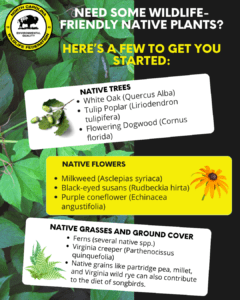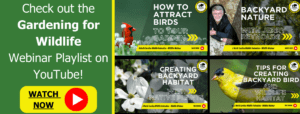Wild Bird Essentials: How to Provide Birds with Shelter, Food, and Water

A significant aspect of conserving wildlife involves the ongoing task of advocating for wildlife and raising voices for those that do not have a voice. This can be achieved by many means, including community organizing, political lobbying, and appeals made to the representatives with the power to enact policy changes for the protection, conservation, and restoration of wildlife throughout the state.
Undoubtedly, advocating and engaging in policy work to enhance the well-being of wildlife species in North Carolina is essential and yields significant impacts on a large scale. However, how can you personally contribute to the well-being of wildlife in your own yard?
In the face of rapid urbanization, unchecked development, burgeoning human populations, and escalating pollution, the toll on habitats and the wildlife within them – through loss, degradation, and fragmentation – is unprecedented.
But a statewide community of people committed to the conservation and protection of these species is the best thing we can offer to North Carolina wildlife – particularly if that community steps up to the task!
 Transforming your property into a more wildlife-friendly – and subsequently wild bird-friendly – environment doesn’t have to be an overwhelming task. At the core of habitat improvement is providing wildlife with the essential elements they need to thrive. These essentials can generally be categorized into four main areas:
Transforming your property into a more wildlife-friendly – and subsequently wild bird-friendly – environment doesn’t have to be an overwhelming task. At the core of habitat improvement is providing wildlife with the essential elements they need to thrive. These essentials can generally be categorized into four main areas:
Food: Native plants provide wildlife with nectar, seeds and berries. Feeders can supplement.
Water: All animals need water to survive and some need water for bathing or breeding.
Cover: Wildlife needs shelter to escape bad weather and predators.
Places to Raise Young: Wildlife needs special habitats for bearing and raising young.
Here are some practical ways you can implement these essential services for wildlife on your property.
Wild Bird Houses
Birdhouses make wonderful additions to your property, addressing two essential categories for wild bird flourishing: providing Cover and offering Places to Raise Young.
 A variety of birdhouse types are available for purchase or installation on your property, and the task of selecting the right one can sometimes feel overwhelming. However, a simple and enjoyable first approach to choosing the perfect birdhouses is to become a backyard birdwatcher!
A variety of birdhouse types are available for purchase or installation on your property, and the task of selecting the right one can sometimes feel overwhelming. However, a simple and enjoyable first approach to choosing the perfect birdhouses is to become a backyard birdwatcher!
Observe the types of birds frequenting the natural areas on your property, aided by a backyard birdfeeder outside a window. This not only attracts birds but also allows you to easily identify common bird species in your area.
Keep in mind that not all birds visit birdfeeders, and different species may prefer various locations on your property. Pay attention to treetops for signs of birds of prey like hawks and owls. Notice woodpeckers scaling tree trunks, or finches and sparrows in grassy areas. Keep your eyes on the ground to spot ground-foraging birds like cardinals, mourning doves, and robins.
Once you’ve identified common (or frequently appearing) bird species on your property, you can proceed to install suitable birdhouses. The Cornell Lab of Ornithology provides building plans for various NC bird species, such as American robins, American kestrels, black-capped chickadees, Carolina wrens, eastern bluebirds, mallards, mourning doves, northern flickers, pileated woodpeckers, purple martins, tufted titmice, and wood ducks.
However, it’s crucial to be aware that certain wild bird species may require state intervention or consultation for optimal care. Examples include red-cockaded woodpeckers, barn owls, ospreys, and more. The North Carolina Wildlife Resources Commission (NCWRC) offers programs addressing the care and protection of these species. When unsure about wildlife species conservation procedures, thorough research and reaching out to NCWRC with any questions are advisable.
When constructing birdhouses, prioritize the safety of the animals. While predators are a natural part of these species’ lives, the use of an unnatural structure may expose them to different dangers. Avoid installing perches on the front of birdhouses, as they provide easy access points for predators like snakes. Consider installing a predator guard beneath the birdhouse on the trunk or pole, with various designs available here.
Remember to incorporate a removable door or panel in your birdhouse for end-of-season cleaning, preventing mold, pests, and bacteria from harming resident birds. Once the house is clean, securely latch it shut to deter predators like raccoons from easily opening the door.
Wild Bird Feeders/Waterers
 Food serves as another crucial habitat feature for wild birds, and birdfeeders offer a delightful and distinctive opportunity to provide sustenance for wildlife – though it often sparks debates within the wildlife conservation community. Putting arguments aside, the solution is straightforward: birdfeeders should function as a supplementary food source for birds. Unfortunately, the seeds offered by birdfeeders are often lacking in nutritional density.
Food serves as another crucial habitat feature for wild birds, and birdfeeders offer a delightful and distinctive opportunity to provide sustenance for wildlife – though it often sparks debates within the wildlife conservation community. Putting arguments aside, the solution is straightforward: birdfeeders should function as a supplementary food source for birds. Unfortunately, the seeds offered by birdfeeders are often lacking in nutritional density.
The majority of a bird’s diet and vital nutrition are derived from caterpillars, larvae, worms, and insects. To address this issue, refer to the steps outlined in the following section, “Plant Native for Wild Birds”.
When it comes to bird feeders, there are numerous options available! Opt for bird feeders that are squirrel and predator-proof, as both can intimidate birds and monopolize the seed. Examples of such feeders include spring feeders, rotating feeders, and more. Position your birdfeeder within natural cover, allowing birds to retreat in case of encroaching predators, especially birds of prey. Maintain a reasonable distance between feeders and windows to minimize the risk of window collisions, which can be fatal for wild birds.
Suet feeders make an excellent addition for woodpeckers and other species less inclined to consume seed from a feeder.
Water Sources:
Offering a bird bath or a petite fountain with chemical-free flowing water provides wildlife with a spot to hydrate and engage in bathing activities. This could manifest as a compact backyard bubbler, a meandering stream feature, or another variant of a water feature.
Ensure that the water source is free from chemicals and dyes, and that there is ample cover along its edges.
Plant Native for Wild Birds
 As previously mentioned, birdfeeders serve as excellent supplementary food sources for wild birds. However, they fall short in providing sufficient nutrition for wild birds, especially in terms of protein.
As previously mentioned, birdfeeders serve as excellent supplementary food sources for wild birds. However, they fall short in providing sufficient nutrition for wild birds, especially in terms of protein.
Seeds offer wild birds essential carbohydrates and sugars, but their primary source of protein comes from insects, worms, and larvae.
Additionally, newly hatched and fledgling birds are unable to consume bird seeds. They depend on their parents to bring them soft, protein-dense caterpillars in substantial quantities.
According to Douglas Tallamy in his book Nature’s Best Hope:
“[It was] found that feeding [for Carolina chickadee young on the nest] rates were 350 to 570 caterpillars per day, depending on the number of chicks in the nest. Over the course of a typical nesting period, which is 16 days on average, chickadee parents delivered 6,000 to 9000 caterpillars to bring one nest of tiny 3 oz birds to fledging.”
The most effective way to provide these protein-rich food sources for wild birds is by incorporating native trees and plants into your yard. Native plants attract a diverse array of native insect species, offering pollination, food sources for other wildlife, and a multitude of ecosystem services.
Discover more about native plant species that can be planted on your property here.
Make It Official
So, you’ve followed all the steps, and you’ve ensured that wild birds have a place to find food, water, cover, and places to raise young on your property. What now?
Make it official by registering your yard as a Butterfly Highway Pollinator Pitstop or Certified Wildlife Habitat!
Certified Wildlife Habitat
In conjunction with the National Wildlife Federation, NCWF offers a Certified Wildlife Habitat program, allowing private landowners the chance to designate their own yards as a safe place for wildlife of all kinds. NC has the 4th highest number of Certified Wildlife Habitats of all time compared with the other states, and you can help lead the charge!
Creating a Certified Wildlife Habitat simply means providing the four key elements wildlife need in order to survive: food, water, cover, and places to raise young. Join other conservation-minded private landowners by certifying your yard, balcony container garden, schoolyard, work landscape or roadside greenspace into a Certified Wildlife Habitat.
Butterfly Highway Pollinator Pitstop
You can convert your yard or garden container to a registered Pollinator Pitstop by taking a few simple measures to provide critical habitat for butterflies and other pollinators:

Join/Register your garden: By registering your yard as a Pollinator Pitstop, you are committing to providing a safe place for pollinators to thrive in both adult and young stages. Your Pollinator Pitstop can be any size and there is no charge to join.
Stay informed: Sign up to receive the weekly Butterfly Highway email newsletter, featuring Pollinator Pitstop highlights, native and invasive plant and wildlife information, and other helpful resources.
Plant NC native pollinator seeds: Expand your current pollinator garden or start a new garden bed by including NCWF’s native pollinator seed mix. Seeds will arrive in a packet that includes a mix of at least 7 different species of native pollinator plants that support both larval and adult stages of local pollinators. Seed packets cover about 25 square feet.
Signs on the Highway: Purchase a Butterfly Highway sign to bring your neighbors and friends onto the Highway with you.
Support the Butterfly Highway: Your investment helps expand pollinator habitat throughout North Carolina through on-the-ground restoration projects, supporting policy that benefits pollinators, and much more.
Want more information on how to make your property a better place for wild birds and other wildlife species?
Written by:

– Bates Whitaker, NCWF Communications & Marketing Manager



